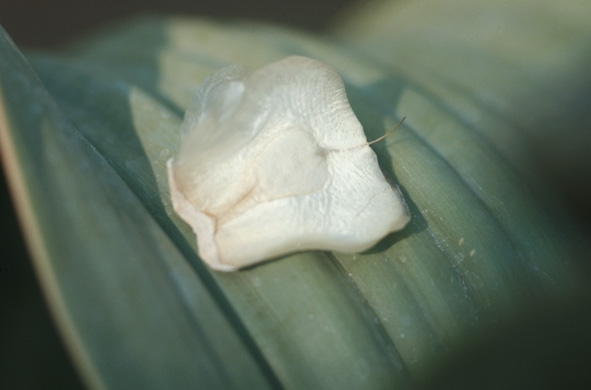Welwitschia mirabilis: a plant
from Tatooine?
For many of us, the first movie in the Star Wars series was a
major media event. On Tatooine, Luke Skywalker's home planet, one
scene, where the two 'droids were going up a rather dry gully that
was devoid of plants, Welwitschia would have fit in quite
nicely. To me, it is one of the strangest plants in the world. Ever
since I was "introduced" to Welwitschia mirabilis in Dr.
Donald Foard's Morphology of the Plant Kingdom class at UCLA, I had
wanted to grow this rather alien looking plant.
In the next few years, I was able to visit several institutions
that had either plants growing or an exhibit. This help me to broaden
my knowlege about how others were growing Welwitschia. It is
interesting how many cultural methods were used. I will have a
separate page of these visits at a later date. Whether the exhibits
are still around, is unknown at this point given that I saw them in
the mid 1960's.
In 1963, seed from Walvis Bay, South Africa (now Namibia) was
obtained through the generosity of a fellow student, Albert J. Hill.
They were sown in quart milk cartons in a pure decomposed gravel
medium where all of the fine material had been sifted out. The tall
milk cartons were to accommodate the long tap root that all of the
literature we read talked about. Germination was rapid-within two
weeks, seedlings had emerged. Within several weeks, the two leaves
were emerging between the two cotyledons.
|
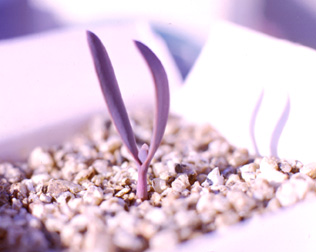
|
Panel 1
This is a close-up of a seedling growing in a quart
milk carton about 3 months old in the UCLA Plant Physiology
greenhouse. The decomposed granite gravel grains are between
1/8 to 1/4 inch in size. The only two leaves the plant will
ever have during its entire life are visible as two small
triangles between the long purplish-red cotyledons.
|
Problems were encountered with the plants in these milk cartons
as the water didn't drain completely from the bottom holes, resulting
in a saturated layer of gravel near the bottom. When the roots
reached this layer, the tips rotted and the rot spread up, eventually
killing the seedlings. All but three of the fourteen original Walvis
Bay seedlings were lost.
(check notebook for dates)
The three remaining seedlings were transplanted to a specially
designed pot and were placed outside against a south facing fence. It
was hoped that the lower humidity outside would aid growth, even
though it was winter. When one seedling died and half of another
began to die, the plants were returned to greenhouse conditions,
being placed where maximum sun would be obtained. Regular watering
and inline fertilization were started. Within a few weeks, recovery
and rapid growth were evident.
can insert pix of #2 here.
Seeds were also obtained from Portuguese sources- the Botanical
Gardens at Coimbra, Portugal and the one at Nova Lisboa (now Huambo),
Angola. Correspondence with Coimbra indicated that their seed was
collected in habitat each year in extreme southwestern Angola near
Cabo Negro (Mossamedes), and they didn't have any growing in
Portugal.
Growth measurements taken for about ten years indicated that
the Angolan population grew about twice as fast as the Namibian
(Walvis Bay) population. The habitat in Angola is definitely more
mesic-grassland savanna, versus extreme desert conditions at Walvis
Bay.
|
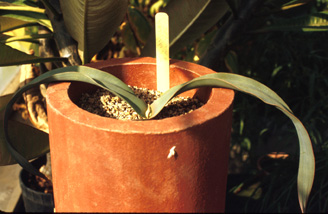
|
Panel 2
#5 21 Febuary 1966- about 15 months after planting
directly into the pot.
|
At UCLA, growth was rapid slowing only during the winter months
due to the short photoperiod. With the coming of spring and longer
days, growth began, indicated by a small band of light green emerging
from the base of the leaves.
|
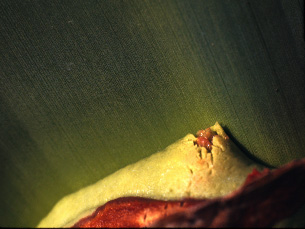
|
Panel 3
What later turned out to be the beginnings of a
strobilus, this small bump shows the start of reproductive
activity.
|
|
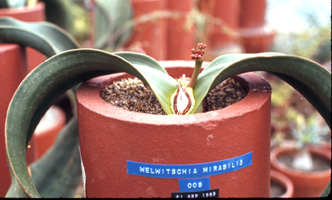
|
Panel 4
The first strobilus, which later turned out to be
staminate (male). The plant (#9- Angolan population) was 3
years and 9 months old at this time. This was the only plant
to produce cones while grown in the same location
(UCLA).
|
|
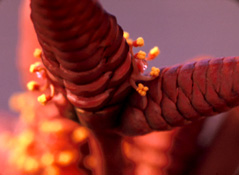
|
Panel 5
A close up view of a group of emerging stamens that
surround a nectary. A drop of nectar can be seen as shiny
spots on both sides of the cone.
|
Here's the rest of the story.... (Lowell Thomas)
|
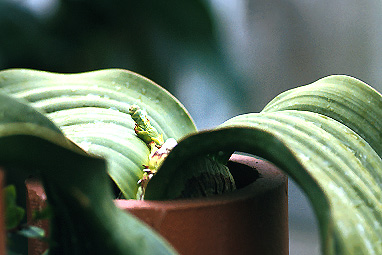
|
Panel 6
Emerged pistillate (megasporangiate) strobilus on
Plant #2 (Walvis Bay population) at 12 years and 7 months
from seed planting.
|
|
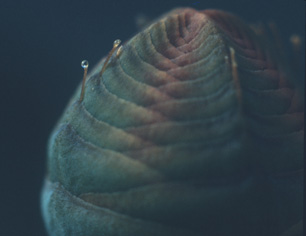
|
Panel 7
The development of the pistillate (megasporangiate)
strobilus is very similar to that of the staminate
(microsporangiate) strobilus except that the developing
cones are much larger, this difference being evident very
early. Again, a droplet of nectar can be seen at the tip of
the pollination tubes (microtubules). Thus, the stage is set
for possible plant-insect interaction. And this is a
gymnosperm!
|
Pollination was effected by using the nectar as a carrier,
dabbing first the stamens with a nectar wetted glass rod and then
dabbing the ends of the microtubules. Due to the abundance of nectar,
the nectar was removed from most of the microtubules first so that
the pollen-nectar mix would not get over diluted. This process was
repeated several times. (check times, as nectar is withdrawn at
certain times.)
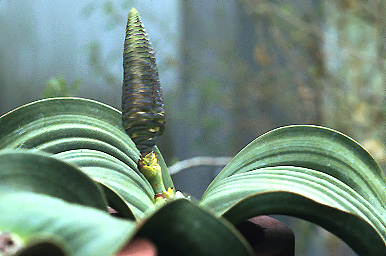
|
Panel 8
A mature megasporangiate strobilus. This was the first
one produced on Plant #2 on 12 November 1976. A total of 57
full seeds resulted.
|
|
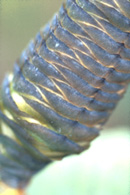
|
Panel 9
This is a close up of the base of the mature female
strobilus. The scales have begun to dry and loosen. Seeds
are released as the cone scales loosen and detach.
|
Panel 10
Close up of a seed on a Welwitschia leaf. The
microtubule, on the right, provides a direct contact to the exterior
and is evident extending into the seed proper as a fine line above
the central seed area and ending at the upper edge of the seed in the
center of the broad wing. The actual seed is delineated by the fine
outline.
The process of growing Welwitschia from seed to seed, in
our case took about 13 years and was published in 1980 by Leo C.
Song, Jr. in the Cactus & Succulent Journal (U.S.) 52(1, 2):
30-32 & 68-73. The Montreal Botanical Garden also did it in 13
years (Teuscher, 1951), and the Stellenbosch Botanical Garden in 23
years (Herre, 1954). Authors cited are referenced in the Cactus &
Succulent Journal article. Another seedling grown entirely at Cal
State Fullerton from our seeds produced a megasporangiate strobilis
in about 10 years. The longer times for some of our plants probably
resulted in part from their stay in a poorly heated and lit
residential greenhouse in the early 1970's. The secret is to give the
plant abundant light and heat with a fast draining growing medium.
Plants can be put on a regular inline fertilization program. With
this treatment, growth is rapid. The first cones seem to be produced
when the plant base reaches a certain minimum size- about
XX cm wide. Times to
produce the first cones vary due to the wide variations in cultural
methods. Methods that favor rapid strong growth will bring the plants
to the reproductive state sooner. Signs (coning signs) are slight
buldges occurring near the outer edges of the center bracts which may
or may not show cracking. One plant (16) showed these signs after
only one year and two months. (See Panel
3 Use your browser's Back button to get back here). This
is not always the case, however, as the last of the original seven
(The Magnificent Seven?) finally produced "her" first cone at about
30 years! This was one of two surviving plants from Walvis
Bay.
Our plants have been used in several research projects. One
done by Irwin Ting that showed that contrary to earlier reports of
crassulacean acid metabolism (CAM) being present, showed no
indication of CAM, but what turned out to be carbon recycling
(cite article here). That
is, under extreme drought stress, Welwitschia closes its
stomates and refixes respiratory carbon dioxide, produced at night,
trapped in the intercelluar spaces during the daylight. However, the
plants can eventually die from total lack of water if their root
system cannot reach deep ground water or pick up water from fog
drip.
Another project, entitled, "The Mostly Male Theory of Flower
Evolutionary Origins: from Genes to Fossils" by Michael w. Frolich
and Davis S. Parker, is in press in Systematic Botany. Looking at the
DNA for cladistic analysis, (more
later), specifically for the LFY gene. This material
and additional material obtained from the Huntington Botanical
Gardens was critical in the execution of this project (Frolich,
personal communication).
We have been producing seed since the early 1970's and when
supplies permit, distribute seed on request to educational
institutions and botanical gardens. Many educational institutions
have plants grown from seed produced here and we are indeed greatly
satisfied that many more people can see and touch this most
interesting plant.
(page still under
construction)
Top of
Page
updated 01 December 2000









